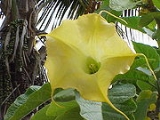
Brugmansia versicolor
Encyclopedia
Brugmansia versicolor is a species of plant
in the Solanaceae
family, commonly referred to as “Angel’s Tear” or “Angel’s Trumpet”. It is endemic to Ecuador
.
taxonomist Christiaan Hendrik Persoon created a separate genus for Brugmansia, but it was not until 1973 that Tom E. Lockwood created a final division between the two genera with his doctoral thesis at Harvard University” (Segalen).
The different genera of the family Solanaceae include many crop plants such as potatoes and tomatoes, as well as several other poisonous plants.

Plant
Plants are living organisms belonging to the kingdom Plantae. Precise definitions of the kingdom vary, but as the term is used here, plants include familiar organisms such as trees, flowers, herbs, bushes, grasses, vines, ferns, mosses, and green algae. The group is also called green plants or...
in the Solanaceae
Solanaceae
Solanaceae are a family of flowering plants that include a number of important agricultural crops as well as many toxic plants. The name of the family comes from the Latin Solanum "the nightshade plant", but the further etymology of that word is unclear...
family, commonly referred to as “Angel’s Tear” or “Angel’s Trumpet”. It is endemic to Ecuador
Ecuador
Ecuador , officially the Republic of Ecuador is a representative democratic republic in South America, bordered by Colombia on the north, Peru on the east and south, and by the Pacific Ocean to the west. It is one of only two countries in South America, along with Chile, that do not have a border...
.
Description
Brugmansia versicolor is a bush or small tree reaching 10–16 feet in height. It has an alternate insertion of elliptic/oblong leaves that are entire with smooth edges. One of the most prominent characteristics of B. versicolor is the presence of giant drooping flowers which hang upside down, which is where it gets its common name of Angel's Trumpet. The flowers are the largest of all Brugmansia at 12–20 inches in length. They are open first white, but then may age to turn peach, pink, apricot or remain white.Taxonomy
There are currently 7 distinct species of Brugmansia recognized, and they are very similar to their close relative Datura. For this reason the two genera were commonly mistaken for one another. “It was not until the discovery of the New World that Brugmansias appeared in the documented floras and later in gardens of the Old World. Initially Brugmansias were grouped with Daturas by the famous botanist Carl Linné, who documented them in 1753 from a drawing and not from live plant material. In 1805, the South AfricanSouth Africa
The Republic of South Africa is a country in southern Africa. Located at the southern tip of Africa, it is divided into nine provinces, with of coastline on the Atlantic and Indian oceans...
taxonomist Christiaan Hendrik Persoon created a separate genus for Brugmansia, but it was not until 1973 that Tom E. Lockwood created a final division between the two genera with his doctoral thesis at Harvard University” (Segalen).
The different genera of the family Solanaceae include many crop plants such as potatoes and tomatoes, as well as several other poisonous plants.
Distribution and habitat
Brugmansia are native to the western part of South America, originating from Guayaquil Basin and south of the Gulf of Guayaquil in Ecuador. They are usually found growing in flat areas at elevations up to 2600ft, but are also frequently cultivated at low elevations throughout the tropics.

